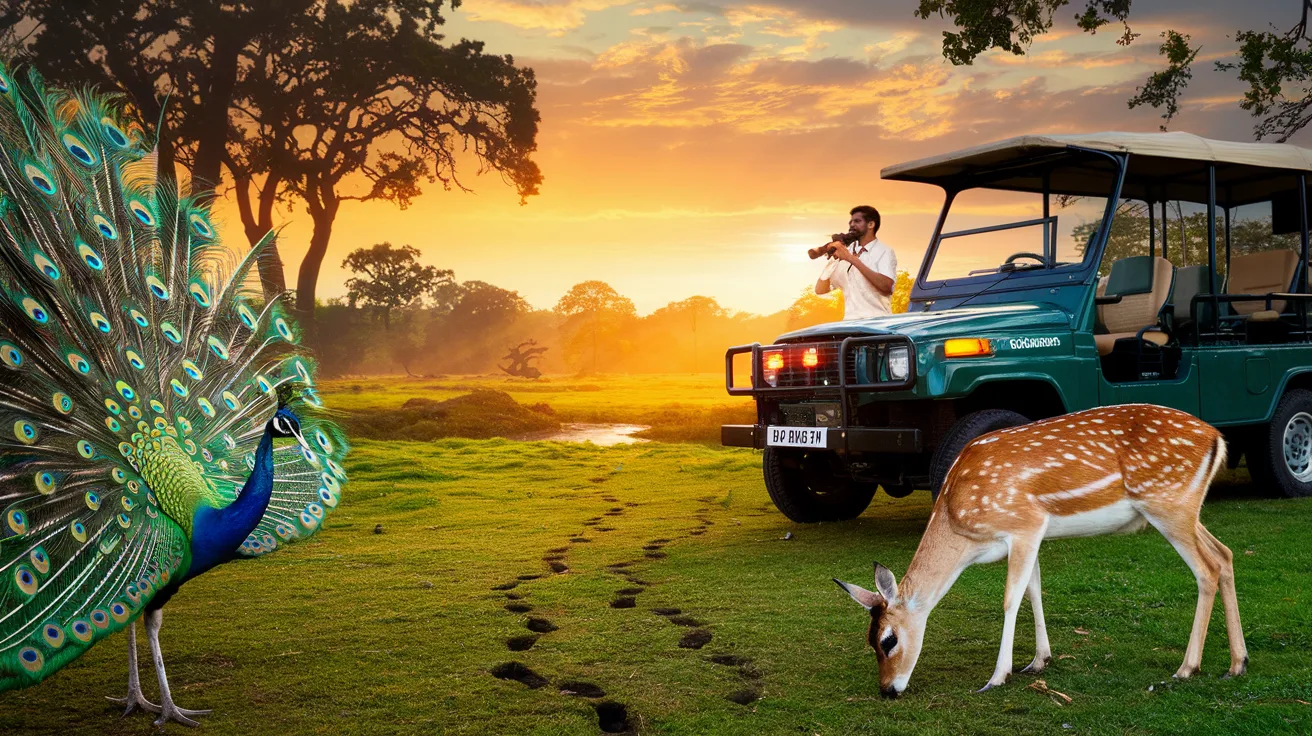Jungle Rhythms: My Exploration of Wildlife Safari in India
Exploring Indian Wildlife Safaris
Rich Biodiversity in India
India is like a treasure chest when it comes to biodiversity. With over 100 national parks, 560 wildlife sanctuaries, and 53 tiger reserves, it plays host to a mind-boggling variety of species. Just think—426 different mammals, 529 reptiles, 1,317 birds, and more than 18,000 kinds of flowering plants. That’s a whole lot of critters (Bandhavgarh National Park).
Now, if you’re talking about icons, the Royal Bengal Tigers are at the top of the list. Their numbers have climbed up from around 1,800 in 2010 to about 2,200 by 2014, thanks to some serious conservation muscle (Journeys International).
Then you’ve got the Indian Sloth Bear with its unmatched shaggy black fur. Once upon a time, they had a not-so-great gig as “dancing bears,” but now they’re safe and sound, with the last of them rescued in 2009 (Journeys International).
It doesn’t stop with tigers and bears. The jungles are alive with an enormous mix of reptiles and plants too. A safari here is anything but dull—it’s closer to jaw-dropping.
Famous Indian Wildlife Reserves
India’s wildlife reserves are like snapshots of nature at its finest, each with its own tales to tell.
Bandhavgarh National Park
Out in Madhya Pradesh, Bandhavgarh National Park is where Royal Bengal Tigers practically strut around. This place is also where the fabled White Tigers of Rewa hailed from. Besides tigers, you’re likely to cross paths with Nilgai, Chital, Wild Boar, and a whole bunch of other furry or feathery friends (Bandhavgarh National Park).
| Animal | Sightings (Yearly Avg.) |
|---|---|
| Royal Bengal Tigers | 50-60 |
| Nilgai | 100-120 |
| Chital | 200-250 |
| Wild Boar | 150-180 |
Jim Corbett National Park
Jim Corbett National Park steals the headline as India’s oldest, established back in 1936. Nestled in Uttarakhand, it’s a sanctuary for tigers, leopards, and elephants. Its landscape features everything from grasslands to lake regions, perfect for all sorts of critters.
Ranthambore National Park
Ranthambore National Park in Rajasthan is another hot spot for wildlife lovers. Its historical aura pairs beautifully with its Royal Bengal Tiger sightings. Leopards, sambar deer, hyenas, and over 300 bird species also call this place home.
| Park | Established Year | Key Species | Area (sq km) |
|---|---|---|---|
| Bandhavgarh National Park | 1968 | Bengal Tigers, Nilgai | 448 |
| Jim Corbett National Park | 1936 | Tigers, Elephants | 520 |
| Ranthambore National Park | 1955 | Tigers, Leopards | 392 |
India’s rich biodiversity and legendary reserves make it a must-see for any wildlife explorer. Each park has its own charm, ensuring no two visits are ever the same.
Majestic Wildlife Species in India
India’s bursting with wildlife that promises an unforgettable adventure for anyone with a heart for nature. When I set off to explore the country’s wilderness, I was completely awestruck by the amazing creatures that live here. Let me share some of the extraordinary animals you might meet on a wildlife safari in India.
Royal Bengal Tigers
If you think of India, you probably picture the Royal Bengal Tiger. These big cats are like rock stars of the jungles, especially in places like Bandhavgarh and Ranthambore. India boasts more than 53 tiger reserves, sheltering around 2,967 tigers. Their eye-catching orange fur with those famous black stripes is a sight you won’t soon forget. Picture them slinking through thick woods or soaking up the sun—they are majestic.
| National Park | Approximate Number of Tigers |
|---|---|
| Bandhavgarh | 84 |
| Ranthambore | 70 |
| Kanha | 60 |
| Jim Corbett | 235 |
Learn More About Bandhavgarh National Park
Indian Sloth Bears
The Indian Sloth Bear, with its bushy black coat and unforgettable look, holds a unique spot in India’s history. They were once famous for being “dancing bears” but thanks to conservation heroes, this practice ended in 2009. Now, you’ll see them happily munching on insects and fruits in the wild.
| Key Facts | Details |
|---|---|
| Coat | Shaggy black |
| Historical Fact | Last “dancing bear” rescued in 2009 |
| Habitat | Forests, grasslands, rocky outcrops |
Indian Bison (Gaur)
Meet the Gaur, or Indian Bison, the tallest of the wild cattle family. You’ll find these sturdy critters roaming in various reserves across India, flexing their muscles. Not much scares them—except maybe humans. Seeing a Gaur in its element, standing like a natural bodybuilder, is a sight to remember.
| Key Facts | Details |
|---|---|
| Size | Tallest wild cattle |
| Predators | Few natural predators, mainly humans |
| Habitat | Forests, grasslands |
Red Pandas
Say hello to the Red Panda, a bundle of cuteness slightly bigger than a house cat. These delightful animals are found in the bamboo forests of the Himalayas. They’re more like raccoons than pandas, despite the name. With their nifty retractable claws and “false thumb,” they rule the treetops.
| Key Facts | Details |
|---|---|
| Size | Slightly larger than a domestic cat |
| Unique Feature | Retractile claws and “false thumb” |
| Habitat | Himalayan bamboo forests |
Seeing these incredible animals for real deepened my love for India’s wildlife. From the mighty Royal Bengal Tiger to the playful Red Panda, each moment in India’s natural habitats is a magical experience filled with awe and wonder.
Top National Parks for Wildlife Safaris
Bandhavgarh National Park
If you’re on the hunt for a Royal Bengal Tiger selfie, Bandhavgarh National Park in Madhya Pradesh is your jackpot. This place is tiger central, boasting more of these magnificent cats per square mile than anywhere else in India. Plus, it’s the birthplace of the famous White Tigers of Rewa. It’s not just tigers though. During my time there, I felt like I was on a first-name basis with animals like Nilgai, Chausingha, Chital, Chinkara, Wild Boar, Fox, and Jackal. Tigers might be the headline act, but the supporting cast here is just as impressive (Bandhavgarh National Park).
| Wildlife | Presence |
|---|---|
| Royal Bengal Tiger | Packed |
| White Tigers | Found First Here |
| Nilgai, Chausingha, Chital, Chinkara | Everywhere |
| Wild Boar, Fox, Jackal | Plenty |
Jim Corbett National Park
Jim Corbett National Park in Uttarakhand is your go-to spot if you’re into sharing the jungle with Serows, Gorals, and Himalayan Tahr, alongside the kings of the jungle, the tigers. India’s own OG wildlife reserve, it’s every nature lover’s dream playground. I remember the rush of adrenaline tracking the elusive tigers through dense forests, grasslands, and riverbanks. Corbett has this hauntingly beautiful vibe, like a nature photographer’s fantasy come to life (Holidify).
| Wildlife | Presence |
|---|---|
| Tigers | Frequently Spotted |
| Serow, Goral, Himalayan Tahr | There |
| Elephants, Sloth Bear, Otters | Mixed Bag |
| Bird Species | Around 600 kinds |
Ranthambore National Park
When it comes to seeing tigers majestically strut around ancient ruins, Ranthambore National Park in Rajasthan takes the crown. My safari felt like I was in an epic historical drama, with tigers being the stars against a backdrop of old forts. It’s not all about tigers, though; Ranthambore offers a bustling wildlife scene with leopards, nilgai, and sambar frequently making guest appearances. Oh, and there’s that epic soundtrack of nearly 300 bird species chattering away.
| Wildlife | Presence |
|---|---|
| Tigers | Everywhere |
| Leopards, Nilgai, Sambar | Plenty |
| Sloth Bear, Hyena | Here Too |
| Bird Species | Around 300 kinds |
These parks offer some of the finest wildlife adventures you’ll find in India. Whether it’s ticking off a tiger sighting in Bandhavgarh, being surrounded by Corbett’s cacophony of life or losing yourself amid Ranthambore’s historic wilderness, each park serves up its own unforgettable slice of wildlife heaven.
Unique Wildlife Safari Experiences
Taking a wildlife safari in India is simply unmatched. Here’s a peek at three outstanding parks where I lived moments I’ll always treasure.
Sundarban National Park
Gliding Through the Mangroves
Way over in West Bengal, Sundarban National Park boasts the biggest mangrove woods on the planet, and it’s a UNESCO World Heritage gem. It’s a biosphere reserve and tiger haven that hooked me with its snazzy band of critters and wild environment. You’ve got the mystical Royal Bengal Tigers stomping around, and you might bump into estuarine crocs, Indian pythons, cute deer, wild pigs, and a bunch of birds and sea creatures. It’s a real animal party out there.
| Wildlife | Star Attractions |
|---|---|
| Mammals | Royal Bengal Tiger, Deer, Wild Boar |
| Reptiles | Estuarine Crocodiles, Indian Pythons |
| Birds | Loads of both water and land birds |
| Sea Creatures | Various fish and crusty critters |
Roaming Sundarban’s waterways on a boat safari had me feeling James Bond-like, giving me a fresh angle to take in the lush plant and animal life. The buzz of maybe spotting a tiger among those thick mangroves? Out of this world!
Hemis National Park
A Cool-Height Adventure
Hiding up in Ladakh, Hemis National Park is India’s champion in sheer size. Known for snowy peaks and dreamy blue lakes, it’s a hotspot for snow leopard spotting, which pulled me in big time. Beyond these stunning big cats, the park hosts Tibetan Wolves, Himalayan Brown Bears, Red Foxes, Himalayan Marmots, and Mountain Weasels.
| Wildlife | Mischievous Ones |
|---|---|
| Mammals | Snow Leopard, Tibetan Wolf, Himalayan Brown Bear |
| Rodents | Himalayan Marmot |
| Other Critters | Mountain Weasel, Red Fox |
Hemis is a paradise for anyone who loves a good hike. Wandering through this untamed terrain with a chance to glimpse those shy beasts was just the kind of thrill ride you’d expect. Surrounded by peaceful settings and jaw-dropping views, it was an adventure for the books.
Sasan-Gir Wildlife Sanctuary
The Realm of Asiatic Lions
Sasan-Gir Wildlife Sanctuary in Gujarat is the sole stage for spotting the Asiatic lion, nowhere else on the planet holds this treat. Plus, the sanctuary is packed with smaller predators like Jackals, Striped Hyenas, and Indian Foxes, not to mention a bunch of birds and reptiles.
| Wildlife | Crowd Pleasers |
|---|---|
| Mammals | Asiatic Lion, Jackal, Striped Hyena, Indian Fox |
| Birds | Plenty of varieties |
| Reptiles | Loads of them |
While on my safari in Sasan-Gir, I hit the jackpot and caught a proud pride of Asiatic lions just hanging out in their neck of the woods. Seeing these rulers of the land in their element was nothing short of inspiring. The sanctuary’s melting pot of life let me run into a broad array of species, rounding off the safari as a complete blast.
Every one of these wildlife safari getaways in India dealt out unforgettable stories and tales to tell. Whether it was scooting through Sundarban’s mangroves, trekking Hemis’s icy expanses, or feasting eyes on lions in Sasan-Gir’s forests, India’s soul-stirring wildlife and diverse scenes kept my adventurous side chuffed and always craving more wild encounters.
Ethical Practices in Safari Operations
Conservation Efforts in India
On my adventure through India’s wild expanses, I saw the tireless work being done to conserve wildlife. Here, conservation isn’t just a word—it’s a way of life. With a rich mix of animals and plants, India takes special care of its unique critters. National parks and protected reserves act like guardians for all kinds of creatures, from rare plants to birds on the brink.
Take Pench Tiger Reserve, nestled in Madhya Pradesh. It’s a bustling hub for Tigers, Leopards, Sloth Bears, and not to mention over 210 kinds of feathered folks. This place, like many, rolls up its sleeves daily to not only protect endangered species but also to teach people why these animals matter (check out Pugdundee Safaris).
Just a quick look at ongoing projects shows the commitment:
| Conservation Project | Location | Target Species |
|---|---|---|
| Project Tiger | All over India | Bengal Tigers |
| Project Elephant | All over India | Asian Elephants |
| Crocodile Conservation Project | Parks & Sanctuaries | Indian Crocodiles |
| Rhino Conservation Project | Kaziranga National Park | One-Horned Rhinoceros |
With mighty efforts like Project Tiger and Project Elephant, India’s tackling poaching and habitat loss head-on. Safe zones and strict law enforcement make it clear—wildlife in India isn’t just surviving; it’s set up to flourish.
Sustainable Safari Camps
One aspect of ecotourism that truly caught my eye was the rise of sustainable safari camps. These camps act as green champions, making sure our footprints are light while boosting local livelihoods.
Think about Asilia’s Dunia Camp in the Serengeti. Run entirely by women, it’s a glowing example of empowering locals while aiming for zero waste. This boosts community morale and sets a benchmark for others to follow (World Nomads).
India’s safari operators are no different, stepping up with admirable practices: keeping a respectful space from wildlife, so the critters don’t feel stressed, and managing waste to curb pollution.
Here’s a peek at what makes these camps stand out:
| Feature | Description |
|---|---|
| Local Employment | Givin’ jobs to locals to nurture sustainable habits |
| Renewable Energy | Leaning on solar and renewable options to slash carbon emissions |
| Waste Management | Mastering recycling and composting to handle trash like pros |
| Wildlife Protection | Sticking to the rules that keep humans and animals at peace |
Choosing these camps means more than a comfy stay and jaw-dropping views. It’s about participating in something bigger. By sticking to ethical safari norms, we help safeguard India’s wild splendor, so it’s around for the next in line craving a taste of nature’s magic.
Tips for a Memorable Safari Experience
I’ve been lucky enough to explore the wilds of India, so let me share some advice you might find handy for your own travel adventure to the other side of the globe. This is how to really get the most from your Indian wildlife safari.
Best Times for Wildlife Safaris
Timing is everything, especially when it comes to spotting animals in their natural habitat. The sweet spot for going on a safari is between February and July. This is when you’ll have the best chance of catching a glimpse of the creatures that call India home. Don’t just take my word for it—remember, it’s backed by all those safari-savvy folks over on Quora.
Here’s a quick peek at the best times to visit some of the top national parks:
| National Park | Ideal Months for Safari |
|---|---|
| Bandhavgarh National Park | February – June |
| Jim Corbett National Park | March – July |
| Ranthambore National Park | February – April |
| Sundarban National Park | February – May |
| Hemis National Park | March – June |
| Sasan-Gir Wildlife Sanctuary | December – April |
Respect the wildlife experts on Quora—they know their stuff.
Expert Holiday Planning Assistance
Figuring out where and when to go can be a head-scratcher. That’s where hiring someone who knows their way around comes in. A holiday planner can turn the chaos into a smooth ride. Imagine not worrying about permits or figuring out when to pack your bags as they tackle the logistics for you and turn your trip into a wildlife bonanza.
Benefits of Hiring an Expert:
- Crafted Itineraries: Personalized trips that align with what you want to do and see.
- Local Smarts: They’ll know the hot spots and when animals are likely to show up.
- Easy-Peasy Planning: They sort everything from permits to places to sleep and ride in.
And hey, while you’re planning, make sure to go green by choosing operators that respect the animals and the planet. Folks like EcoTour Adventures from Wyoming come to mind (thanks, World Nomads). Look for safari setups like Dunia Camp in the Serengeti, run with locals and eco-friendliness in mind—also tipped by those Nomads.
Pick the right time and get some expert advice, and you’ll have stories about your time in the wilds of India that’ll last a lifetime.







